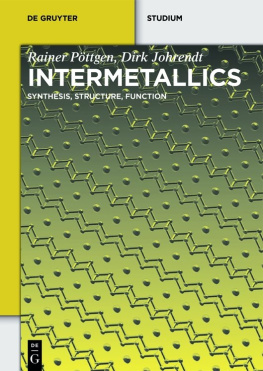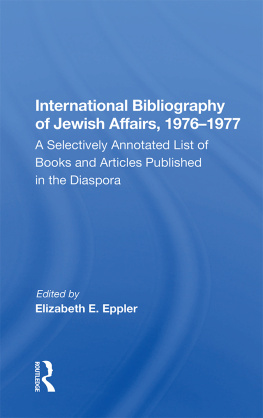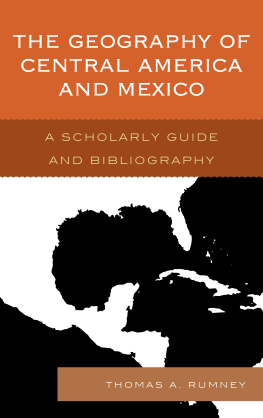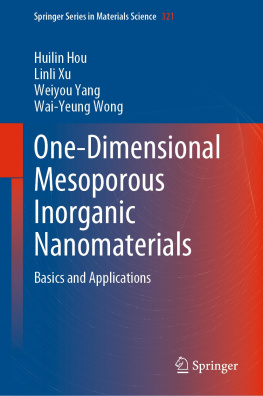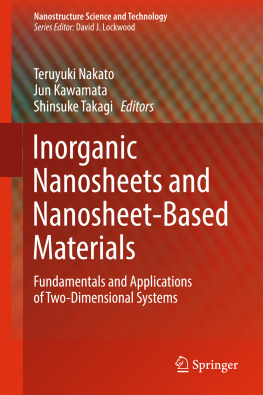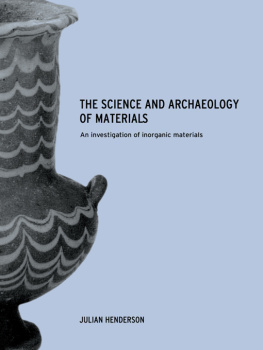Pierre Villars - Inorganic Substances Bibliography
Here you can read online Pierre Villars - Inorganic Substances Bibliography full text of the book (entire story) in english for free. Download pdf and epub, get meaning, cover and reviews about this ebook. year: 2013, publisher: De Gruyter, genre: Children. Description of the work, (preface) as well as reviews are available. Best literature library LitArk.com created for fans of good reading and offers a wide selection of genres:
Romance novel
Science fiction
Adventure
Detective
Science
History
Home and family
Prose
Art
Politics
Computer
Non-fiction
Religion
Business
Children
Humor
Choose a favorite category and find really read worthwhile books. Enjoy immersion in the world of imagination, feel the emotions of the characters or learn something new for yourself, make an fascinating discovery.
- Book:Inorganic Substances Bibliography
- Author:
- Publisher:De Gruyter
- Genre:
- Year:2013
- Rating:4 / 5
- Favourites:Add to favourites
- Your mark:
- 80
- 1
- 2
- 3
- 4
- 5
Inorganic Substances Bibliography: summary, description and annotation
We offer to read an annotation, description, summary or preface (depends on what the author of the book "Inorganic Substances Bibliography" wrote himself). If you haven't found the necessary information about the book — write in the comments, we will try to find it.
By browsing about 10 000 000 scientific articles of over 200 major journals some 200 000 publications were selected. The aim of this Bibliography is to provide researchers with a comprehensive compilation of all up to now published scientific publications on inorganic systems in only three handy volumes.
Inorganic Substances Bibliography — read online for free the complete book (whole text) full work
Below is the text of the book, divided by pages. System saving the place of the last page read, allows you to conveniently read the book "Inorganic Substances Bibliography" online for free, without having to search again every time where you left off. Put a bookmark, and you can go to the page where you finished reading at any time.
Font size:
Interval:
Bookmark:
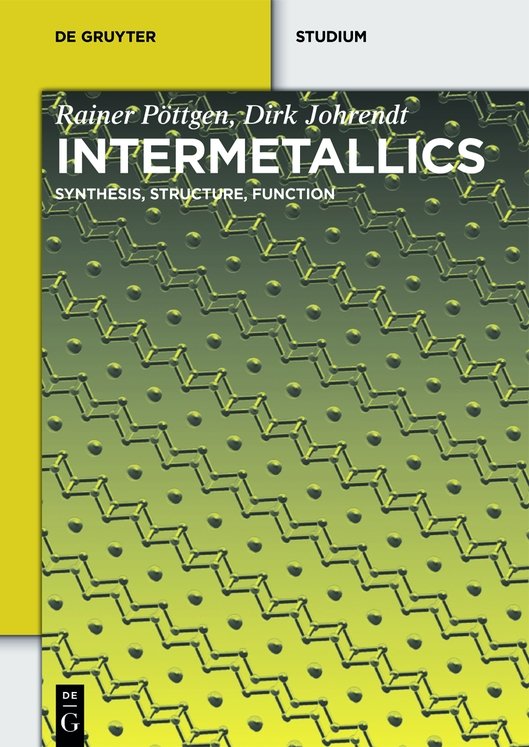
Intermetallic compounds and alloys are a highly important class of modern functional and construction materials, e. g. steels, bronzes, brasses, light-weight alloys for aerospace and vehicle construction, permanent magnetic and magnetic recording materials, shape memory metals, solders, jewelry metal, cutting tools, catalysts, thermoelectric materials, superconductors, battery materials, and many more. In view of the high impact on the gross national product, basic knowledge of these materials should be a prerequisite for a chemist, physicist and materials scientist.
More than 80 elements of the Periodic Table are metals. They crystallize with the closest-packed structure types or the bcc structure, but also more complicated normal- and high-pressure modifications are known. Thus, already the metallic elements show a broad range of structures, bonding peculiarities and physical properties. In going to binary, ternary, quaternary or even multinary compounds one ends up with an incredible amount of phases. The plethora of crystallographic data of these phases is compiled in different data bases, e. g. the Pearson [1] or the ICSD [2, 3] data base. These modern data bases allow for efficient search of element combinations, cell sizes and diverse crystallographic parameters like Pearson symbols, Wyckoff sequences, etc. Phase diagram information is available in different compilations [46].
The incredible amount of structures and crystallographic data readily calls for systematization. Different classes of alloys and intermetallic compounds have already been summarized and reviewed in different books [710]. These books mostly cover very specialized topics of the field of intermetallics and they might be too comprehensive for a Master or PhD student interested in this kind of chemistry. The present initiative is not just another compilation on intermetallics. It is meant as an introduction to this broad field on the level of final Master studies. An inevitable prerequisite for the study of this book is the knowledge of basic inorganic crystal chemistry [1113] as well as some basics in space group and X-ray crystallography [14, 15].
The book is written from a synthetic solid state chemists points of view. Due to the enormous combinatorial variety, it is impossible to know and consider all classes of intermetallic compounds. Nevertheless, we hope that we made a good compromise and covered most of the basic materials. In all subchapters we present a broad literature overview. The interested reader can use this secondary literature (books and review articles) for further, deeper information. The book is divided into three larger topics (i) Synthesis, (ii) Structure, and (iii) Function, which cover most basic aspects. In those cases where properties are directly related to a special compound, they are already mentioned along with the structural data in .
 References
References
- [1] P. Villars, K. Cenzual, Pearsons Crystal Data Crystal Structure Database for Inorganic Compounds , Release 2013/14, ASM International, Materials Park, Ohio, USA, 2013 .
- [2] ICSD Inorganic Crystal Structure Database , Fachinformationszentrum Karlsruhe, 2012 .
- [3] R. Allmann, R. Hinek, Acta Crystallogr. A 2007 , , 412.
- [4] W. G. Moffat (Ed.), The Handbook of Binary Phase Diagrams , Genium Publishing Corporation, New York, 1984 .
- [5] T. B. Massalski, Binary Alloy Phase Diagrams , Vols. 1 and 2, American Society for Metals, Ohio, 1986 .
- [6] G. Petzow, G. Effenberg (Eds.), Ternary Alloys A Comprehensive Compendium of Evaluated Constitutional Data and Phase Diagrams , VCH, 1988 .
- [7] G. Sauthoff, Intermetallics , VCH-Verlagsgesellschaft, Weinheim, 1995 .
- [8] J. H. Westbrook, R. L. Fleischer, Intermetallic Compounds , Volumes 13, John Wiley & Sons, Chichester, England, 2002 .
- [9] R. Ferro, A. Saccone, Intermetallic Chemistry , Elsevier, Amsterdam, 2008 .
- [10] J.-M. Dubois, E. Belin-Ferr, Complex Metallic Alloys Fundamentals and Applications , Wiley-VCH, Weinheim, 2011 .
- [11] D. M. Adams, Inorganic Solids , J. Wiley & Sons, London-NewYork-Sydney-Toronto, 1974 .
- [12] A. R. West, Solid State Chemistry and its Applications , J. Wiley & Sons, Chichester-NewYork-Brisbane-Toronto-Singapore, 1990 .
- [13] U. Mller, Anorganische Strukturchemie , Vieweg + Teubner, 6. Aufl., Wiesbaden, 2008 ; Inorganic Structural Chemistry , 2nd Ed., J. Wiley & Sons, Chichester-NewYork-Brisbane-Toronto-Singapore, 2006 .
- [14] W. Borchardt-Ott, Crystallography An Introduction , 3rd Ed., Springer, 2011 .
- [15] W. Kleber, H.-J. Bautsch, J. Bohm, D. Klimm, Einfhrung in die Kris tallograp hie , 19. Aufl., Oldenbourg, 2010 .
solders, prosthetic alloys and superalloys in mind. On the other hand there is a broad community of solid state chemists, physicists, metallurgists, and materials scientists working in diverse areas of fundamental research of intermetallics. The purity of the elements and the technical requirements are different, whether one works with several tons of a material or uses samples on a milligram scale in research. Concerning the important technical processes we refer to the well known Ullmanns Encyclopedia of Technical Chemistry . Herein we focus on the requirements for sample preparation on the laboratory scale in order to perform structural analyses and property investigations for basic materials characterization.
Most intermetallic compounds are synthesized directly from the elements using the techniques that are discussed in the following subchapters. The use of very pure starting materials is an indispensable prerequisite for the synthesis of pure samples. Today many elements can be purchased directly from the suppliers in pure form, however, the experimentalist should always be extremely vigilant, since introduced impurities can irreversibly affect the reactions and thus the product formation. Often purities of metals are only given with respect to other metallic impurities and it is then not clear to what degree non-metallic impurities might be present as well. Especially if the form of the used metals exhibits a large surface, this is the case for fine powders, these metals might easily react with moisture. Typical impurity phases are then oxydic or hydroxidic surface cusps. Such surface impurities are generally observed e . g . on the cauliflower-like surface of electrolytically reduced manganese chips. The dark-brown layer can easily be removed by diluted nitric acid. As an example we show a contaminated and a cleaned manganese chip in . Transparent oxidic or hydroxidic coatings often occur on compact pieces of aluminum or magnesium. These elements are mostly purchased in the form of rods. Prior to use one should carefully mill a small surface layer on a turning lathe in order to obtain a pure surface. Generally, when available and suitable, it is always advantageous to use large metal pieces in order to keep the surface area minimal.

A surface oxidized/hydrolyzed manganese chip (left) which was subsequently cleaned with diluted nitric acid (right). One square has a size of 6 6 mm2.
Oxidic impurities can also occur in rare earth metals. Especially europium and ytterbium are susceptible to such impurities. Small amounts of ferromagnetic EuO ( T C = 70 K) or antiferromagnetic Yb2O3 ( T N ~ 3 K) in the starting materials can irreversibly affect magnetic property measurements. These two elements should exclusively be used in freshly distilled form in order to get phase pure samples.
Font size:
Interval:
Bookmark:
Similar books «Inorganic Substances Bibliography»
Look at similar books to Inorganic Substances Bibliography. We have selected literature similar in name and meaning in the hope of providing readers with more options to find new, interesting, not yet read works.
Discussion, reviews of the book Inorganic Substances Bibliography and just readers' own opinions. Leave your comments, write what you think about the work, its meaning or the main characters. Specify what exactly you liked and what you didn't like, and why you think so.

